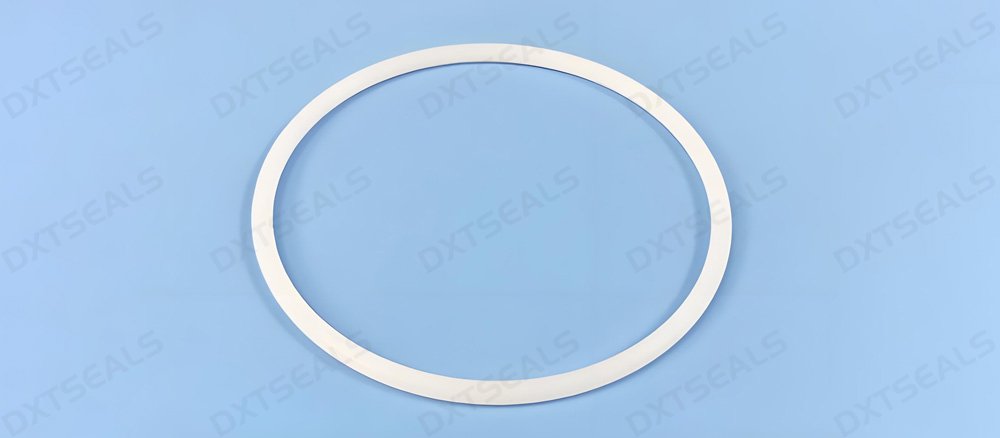
In industries where hygiene, safety, and precise functionality are paramount, the materials used for sealing components must meet stringent standards. Silicone O-rings and PTFE O-rings are two of the most widely used sealing solutions in the food and pharmaceutical industries, where contamination prevention and chemical resistance are critical. In this article, we’ll explore the unique properties of silicone and PTFE O-rings and explain their essential roles in ensuring the safety and efficiency of these industries.
1. Understanding Silicone and PTFE O-Rings
Before diving into their roles in food and pharmaceutical applications, let’s define these two materials:
-
Silicone O-Rings: Made from high-quality silicone rubber, these O-rings are known for their flexibility, high-temperature resistance, and biocompatibility. Silicone is a non-toxic material, making it ideal for applications where cleanliness and safety are critical.
-
PTFE O-Rings: PTFE (Polytetrafluoroethylene) is a synthetic fluoropolymer known for its exceptional chemical resistance, low friction properties, and thermal stability. PTFE O-rings are often used in environments where exposure to aggressive chemicals or extreme temperatures is common.
2. Why Silicone and PTFE O-Rings Are Essential in the Food and Pharmaceutical Industries
The food and pharmaceutical industries have specific requirements when it comes to sealing components. These sectors are governed by strict regulations to ensure product safety, efficacy, and hygiene. Both silicone and PTFE O-rings offer several advantages that make them suitable for these industries:
a) FDA and Food-Safe Certifications
-
Silicone O-Rings: Silicone is inherently non-toxic and can be manufactured to meet FDA (Food and Drug Administration) regulations for food-safe applications. This makes silicone O-rings ideal for use in food processing, packaging, and preparation equipment where contamination risks must be minimized.
-
PTFE O-Rings: PTFE is also an FDA-approved material for food and pharmaceutical applications. It is resistant to a wide variety of chemicals, making it suitable for environments that require resistance to aggressive substances, such as in pharmaceutical manufacturing or food-grade machinery cleaning.
Both materials provide FDA-compliant sealing solutions that ensure safe interaction with food and pharmaceutical products.
b) High-Temperature Resistance
-
Silicone O-Rings: One of the key properties of silicone is its ability to withstand high temperatures without degrading. Silicone O-rings can operate in temperature ranges from -55°C to +230°C, making them suitable for sterilization processes, autoclaving, and food cooking systems where heat exposure is significant.
-
PTFE O-Rings: PTFE O-rings also exhibit excellent thermal stability, functioning in temperatures ranging from -200°C to +260°C. This makes them ideal for pharmaceutical processes that involve extreme temperature conditions, such as high-temperature sterilization and mixing.
Both materials are well-suited for applications where temperature fluctuations or high-heat environments are a factor.
c) Chemical and Fluid Resistance
-
Silicone O-Rings: Silicone is highly resistant to water, steam, and many cleaning chemicals commonly used in the food industry. This resistance makes silicone O-rings ideal for food processing lines where cleaning and sanitization are regular practices.
-
PTFE O-Rings: PTFE is renowned for its superior resistance to almost all chemicals, oils, and solvents, making PTFE O-rings indispensable in pharmaceutical applications where exposure to harsh chemicals, acids, or bases is common. PTFE also has a non-stick surface, which helps prevent buildup of contaminants.
In both the food and pharmaceutical industries, these materials ensure that seals maintain integrity, even in harsh chemical or high-moisture environments.
d) Biocompatibility and Hygiene
-
Silicone O-Rings: Silicone is biocompatible, which means it can safely be used in applications where it might come into contact with humans or animals. Its non-porous surface makes it highly resistant to microbial growth, making it perfect for use in pharmaceutical drug manufacturing and food handling systems.
-
PTFE O-Rings: PTFE is similarly non-porous and does not promote bacterial growth, making it an excellent choice for sterilization in pharmaceutical and food applications. Its inert properties ensure that there is no contamination risk, which is vital for maintaining the integrity of drugs and food products.
Both materials contribute significantly to maintaining hygiene and product safety in regulated environments.
3. Applications of Silicone and PTFE O-Rings in the Food and Pharmaceutical Industries
Here are some common applications for silicone and PTFE O-rings in these critical industries:
Food Industry:
- Food Processing Equipment: Silicone O-rings are often used in food processing machinery, including mixers, blenders, and sterilizers, due to their high-temperature resistance and non-toxic properties.
- Packaging and Sealing: PTFE O-rings are commonly used in food packaging machinery where resistance to oils, chemicals, and heat is essential for preventing contamination during packaging.
- Beverage Production: In beverage production, both silicone and PTFE O-rings are used to seal valves, pumps, and filtration systems, ensuring that products remain uncontaminated during processing.
Pharmaceutical Industry:
- Drug Manufacturing: Silicone O-rings are used in pharmaceutical manufacturing equipment, including tablet presses and liquid filling machines, to ensure no contaminants are introduced into the production process.
- Sterilization and Autoclaves: PTFE O-rings are widely used in autoclave sealing systems for pharmaceutical equipment, where high-temperature and high-pressure environments are required for sterilization.
- Bioreactors: PTFE O-rings are used in bioreactors for pharmaceutical and biotechnology applications, where they provide chemical resistance and prevent any potential leakage of volatile or sensitive substances.
4. Choosing the Right O-Ring Material for Your Application
Selecting the correct sealing material is crucial in the food and pharmaceutical industries. When choosing between silicone and PTFE O-rings, consider the following:
- Silicone is best for applications involving high temperatures and where flexibility and biocompatibility are important.
- PTFE is ideal for chemical resistance and applications where exposure to harsh solvents, acids, or bases is expected.
5. Conclusion
In the food and pharmaceutical industries, silicone and PTFE O-rings play a vital role in maintaining safety, hygiene, and product quality. Both materials offer distinct advantages based on the specific needs of the application, including temperature tolerance, chemical resistance, and compliance with FDA regulations. At DXTSEALS, we offer high-quality silicone and PTFE O-rings that meet the rigorous standards of the food and pharmaceutical industries, ensuring reliable performance and contamination-free sealing.
